Thunderbolt 3 in Action: Akitio Thunder3 Duo Pro DAS Review
by Ganesh T S on April 14, 2016 8:30 AM EST- Posted in
- Storage
- DAS
- Thunderbolt 3
- Akitio
Direct-Attached Storage Performance
Given the presence of two bays, it is clear that the system needs to be fitted with SSDs in order to deliver maximum performance. We chose two Intel DC S3510 240GB SSDs as the members of a RAID-0 array for benchmarking purposes. Prior to taking a look at the real-life benchmarks, we first check what ATTO and CrystalDiskMark have to report.
ATTO shows performance numbers close to 800 MBps for large-sized reads, and it is backed up somewhat by CrystalDiskMark also.
In order to tackle the first real-life use-case, we created three test folders with the following characteristics:
- Photos: 15.6 GB collection of 4320 photos (RAW as well as JPEGs) in 61 sub-folders
- Videos: 16.1 GB collection of 244 videos (MP4 as well as MOVs) in 6 sub-folders
- BR: 10.7 GB Blu-ray folder structure of the IDT Benchmark Blu-ray (the same that we use in our robocopy tests for NAS systems)
| Akitio Thunder3 Duo Pro + 2x Intel SSD DC S3510 (Thunderbolt 3) robocopy Benchmarks (MBps) |
||
| Write Bandwidth | Read Bandwidth | |
| Photos | 526.00 | 398.80 |
| Videos | 522.75 | 538.06 |
| Blu-ray Folder | 525.68 | 568.55 |
The above benchmark run was also instrumented to record the temperature of one of the SSDs as well as the instantaneous transfer rate to the DAS unit during the process. The internal disk temperature never exceeded 38 C even after more than 127 GB of writes and 127 GB of reads continuously.
For the second use-case, we take advantage of PC Mark 8's storage bench. The storage workload involves games as well as multimedia editing applications. The command line version allows us to cherry-pick storage traces to run on a target drive. We chose the following traces.
- Adobe Photoshop (Light)
- Adobe Photoshop (Heavy)
- Adobe After Effects
- Adobe Illustrator
Usually, PC Mark 8 reports time to complete the trace, but the detailed log report has the read and write bandwidth figures which we present in our performance graphs. Note that the bandwidth number reported in the results don't involve idle time compression. Results might appear low, but that is part of the workload characteristic. This is not the intended use-case for portable hard drives, but the results are just presented here for the sake of completeness
| Akitio Thunder3 Duo Pro + 2x Intel SSD DC S3510 (Thunderbolt 3) PCMark8 Storage Benchmarks (MBps) |
||
| Write Bandwidth | Read Bandwidth | |
| Adobe Photoshop (Light) | 612.44 | 167.14 |
| Adobe Photoshop (Heavy) | 578.53 | 225.74 |
| Adobe After Effects | 265.09 | 227.90 |
| Adobe Illustrator | 488.68 | 217.72 |
While the above numbers are very good, and what one expects from two SSDs in RAID-0, they do not bring out the real capabilities of Thunderbolt 3. For that purpose, we need to daisy chain multiple units.
Prior to looking at the daisy chaining results, let us see how the unit performs when fitted out with a couple of high-capacity hard disks in RAID-0. This is probably the configuration that most users would choose when looking for large amounts of fast and affordable storage. Two 8TB Seagate Enterprise NAS HDDs were installed in one of the units and all benchmarks that were run for the SSD configuration were repeated.
Note that the HDD configuration provides lower bandwidth, but much higher consistency. There is also not much benefit to higher queue depths in this configuration. The consistency aspect is also brought out in the performance consistency test.
| Akitio Thunder3 Duo Pro + 2x 8TB Seagate Enterprise NAS HDDs (Thunderbolt 3) robocopy Benchmarks (MBps) |
||
| Write Bandwidth | Read Bandwidth | |
| Photos | 346.22 | 301.99 |
| Videos | 376.31 | 348.88 |
| Blu-ray Folder | 372.49 | 375.63 |
| Akitio Thunder3 Duo Pro + 2x 8TB Seagate Enterprise NAS HDDs (Thunderbolt 3) PCMark8 Storage Benchmarks (MBps) |
||
| Write Bandwidth | Read Bandwidth | |
| Adobe Photoshop (Light) | 316.60 | 9.93 |
| Adobe Photoshop (Heavy) | 292.50 | 12.45 |
| Adobe After Effects | 71.11 | 9.58 |
| Adobe Illustrator | 204.77 | 9.06 |
We now move on to the results from our daisy-chaining experiments.


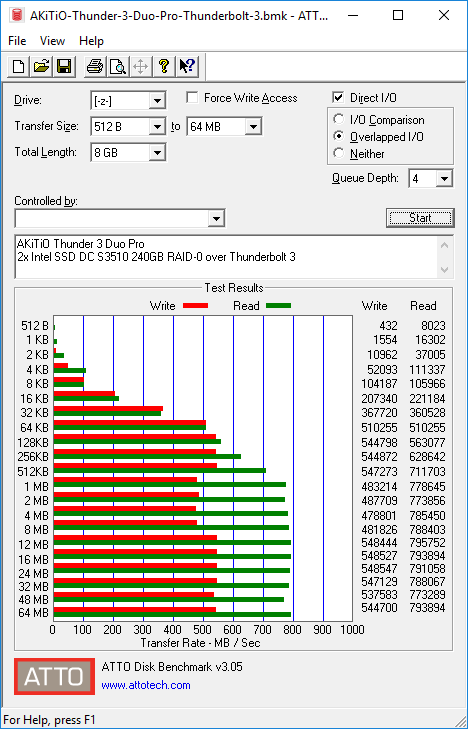
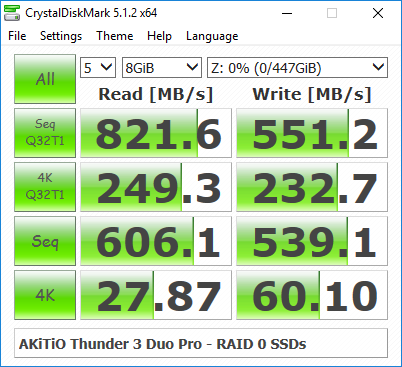

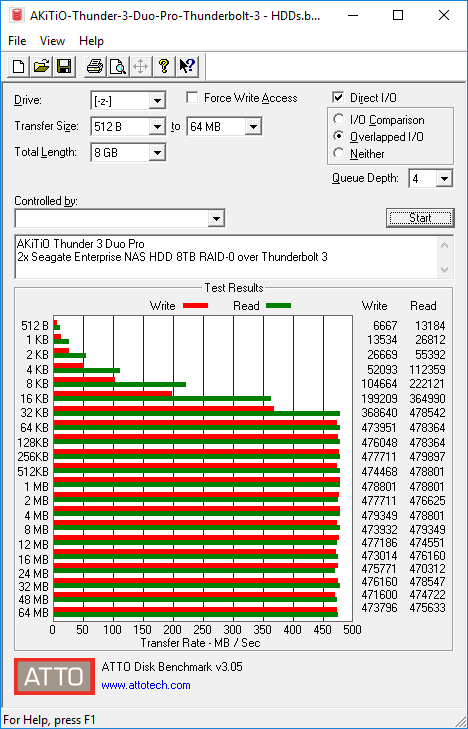
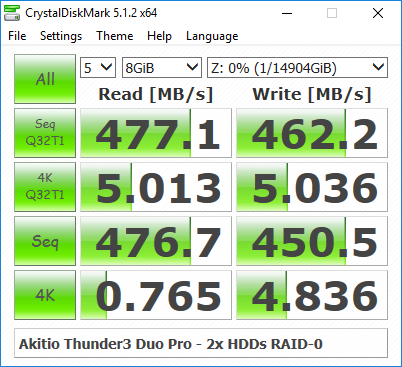
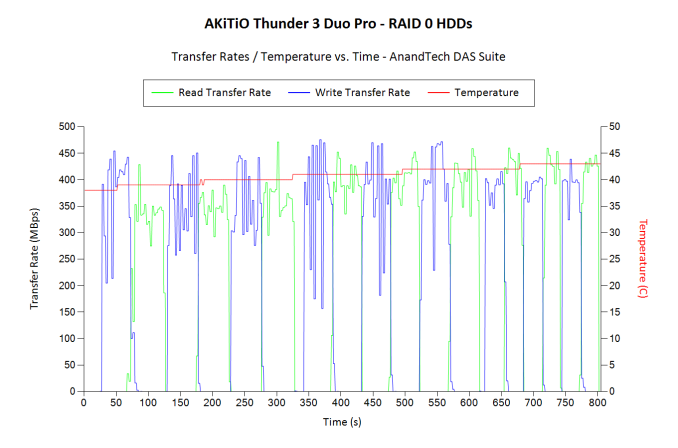








60 Comments
View All Comments
name99 - Thursday, April 14, 2016 - link
I don't understand this obsession with daisy-chaining. Daisy-chaining is a LOUSY technology. It's been a lousy technology in every damn form it's ever shipped, whether SCSI, ADB, firewire, or thunderbolt. One of the few things USB actually got right from the start was to make it clear on day one that their expansion solution was hubs, not daisy-chaining.Why does it suck?
- It substantially reduces your power-on-off flexibility. This may not matter in a testing lab, but in the real world there are constant reasons why you might want to power a device off. With a hub this is a simple issue; with a daisy-chain it requires considering the implications of everything that is connected, and generally unmounting a bunch of devices then changing the topology.
- right now when it's all skittles and roses, every thunderbolt device comes with two ports. But as soon as this goes mainstream, the usual attempts at cost-cutting will have one device after another shipping with only one port. And then what happens to your chaining?
Because USB got this right on day one, USB hubs have always been cheap as dirt. Everybody owns one, and devices that need to present the illusion of daisy-chaining (like keyboards with two USB ports, one for the mouse to connect to; or displays with USB connectors) just stick in a cheap USB hub chip. Because Firewire (and the other specs I mentioned) did NOT get this right, FW hubs never became cheap. Even the FW400 hubs were expensive, and I don't think decent FW800 hubs were EVER produced (when I was looking for them, the best I could find was a pathetic two port hub).
Instead of cheering how great Thunderbolt daisy-chaining is, you should be considering the reality that, because Intel has insisted on doing things this way (in spite of THIRTY YEARS of evidence that it is a stupid idea) they are likely going to snatch defeat from the jaws of victory. All those thunderbolt-enabled USB C ports will ACTUALLY land up connected to pure USB3.1 hubs, which will in turn, once again, mean that USB3.1 is the only really viable mass market for storage, and these super-high-end storage solutions (and external GPUs, etc) will continue to remain irrelevant to the mass market.
Nice going Intel --- turns out instruction sets are not the only things you're incapable of handling competently.
Klug4Pres - Friday, April 15, 2016 - link
Enjoyable rant, thanks!Wardrop - Friday, April 15, 2016 - link
I'm sure Apple, who are obsessed with having a single cable for everything, would have been the ones who pushed Intel to support daisy chaining.Daisy chaining isn't a bad idea if implemented properly though. It should be passive to really work, as in, a physically unplugged device should be able to pass through a thunderbolt signal. Like a switch that opens and closes depending on whether the device is powered on or not.
galta - Friday, April 15, 2016 - link
A little bit angrier than I would have expected, but correct in its essence.All these weird proprietary interfaces fail for a combination of high costs and lack of scale. All of us - or at least most of us - remember when microchannel was thought to be the future and we all know were it ended.
As someone said before, Thunderbolt, as well as FireWire in its time, will make sense only for the 15 people who make 4k video editing on a 5k monitor on their Apples.
The remaining will be more than glad to remain with USB.
zodiacfml - Friday, April 15, 2016 - link
Same here. I never understood daisy chaining. I just dismissed it long ago that some people use the feature.ganeshts - Friday, April 15, 2016 - link
Daisy chaining is a feature that is available.It is not mandatory that it needs to be used.
Most people can just use a dock and it would have all the types of USB 3.x ports that they need.
The beauty of Thunderbolt 3 is that it allows for just a single interface in sleek products, and it will have an ecosystem that allows people to pick and choose what interfaces they want in their system when 'docked' - that can't be said for proprietary interfaces developed by system vendors. (though I do agree that Thunderbolt being restricted to Intel-only systems is a bit of an issue in the long run - if AMD manages to claw back to performance parity with mid-range and higher Intel systems)
hyno111 - Friday, April 15, 2016 - link
The ATTO and CrystalDiskMark result for SSD RAID is missing.ganeshts - Friday, April 15, 2016 - link
My apologies. There was a CMS issue when we updated the HDD results. It is now fixed.epobirs - Saturday, April 16, 2016 - link
Considering the main bottleneck here is going to be SATA, it seems like the box could have been implemented with USB 3.1 Gen 2 and delivered the same performance at lower cost. Even with two SSDs rather than platter drives, the best throughput after overhead should rarely exceed what USB 3.1 can handle.Down the road, a box with slots for, say, four U.2 SSDs, should really utilize Thunderbolt 3's bandwidth while still being small enough to consider portable. THAT would be worth spending a good amount for a professional user, being able to access live data or do very large backups at those speeds in a rig small enough to go on a location shoot comfortably.
ganeshts - Saturday, April 16, 2016 - link
Definitely.. the performance of a single unit is very close to that of the bus-powered SanDisk Extreme 900 we reviewed before. However, this unit is clearly meant to introduce the benefits of Thunderbolt 3 to the market - DisplayPort output, daisy chaining with docks for extra functionality etc. The storage bandwidth from a single unit is not the main focus, as this is one of the first Thunderbolt 3 devices to be introduced. We will soon see high bay-count devices with Thunderbolt 3 at NAB next week - Accusys has already pre-announced a 12-bay one.